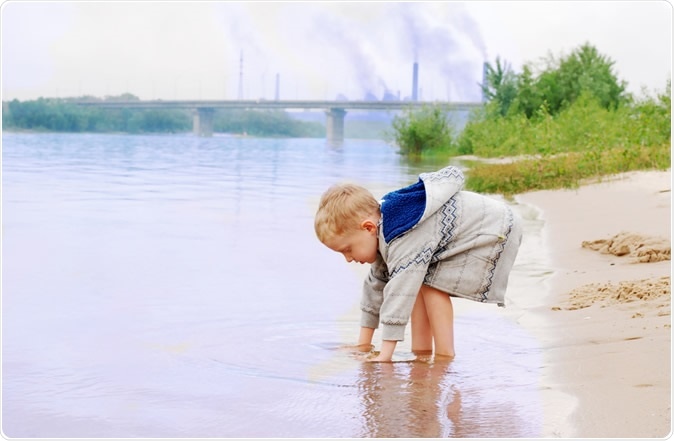Hypertension or high blood pressure is a major killer worldwide, accounting for much death and disease burden due to cardiovascular disease. Multiple factors influence the risk for this condition, some acting in adulthood but some operating from birth or even earlier.

Image Credit: Soloviova Liudmyla / Shutterstock
A new study looks at multiple factors that act together to affect the blood pressure in childhood, beginning in utero, that is, before a child is even born. For instance, the place where the mother lives during pregnancy, the local temperature, and chemical pollution, are just a few of the risks that may impinge upon the child’s physiology to help determine the occurrence of high blood pressure during childhood.
Apart from cardiovascular health in women as a result of pregnancy-related lifestyles, including obesity, drinking and smoking, we are now realizing that the unborn child may be predisposed to develop high blood pressure in response to these risk factors. Many studies have focused on the effects caused in the developing fetus by exposure to a single agent, but few have looked at the interactions or synergistic effects of being at the receiving end of more than one risk factor.
The study
The researchers looked at more than 1,200 children between the age of 6 and 11 years and their mothers, from a cohort recruited for the European HELIX (Human Early-Life Exposome) project. These pairs were drawn from the UK, Spain, France, Norway, Lithuania and Greece. All the children were healthy at the time of examination. Overall, about 10% of the children either had hypertension or had increased blood pressure that fell short of the diagnostic criteria for hypertension – a state called prehypertension.
They were evaluated for both prenatal and postnatal exposures, such as air pollution, natural spaces, lifestyle, chemicals in the environment, noise levels, and the built-up surroundings. After analysis of the data, confounding factors were accounted for to arrive at an adjusted risk for the incidence of hypertension following exposure to these factors. Altogether, the researchers looked at 89 and 128 exposures in pregnancy and early childhood.
What does the study show?
From the data on exposure, the children were classified into quartiles of risk exposure. The broad picture showed that four environmental factors affected blood pressure in the children:
- The actual building and its surroundings where the mother lived while she was pregnant
- The outdoor temperature
- Intake of fish during pregnancy
- Chemical exposure
The risk for blood pressure changes was observed to change in relation to successively increased quartiles of exposure. Overall, if the environment during pregnancy with accessible green spaces, facilities for shops and public transport, blood pressure in the children was more likely to be normal. This could be due to more physical activity during pregnancy, suggest the researchers.
Increased blood pressure
The systolic blood pressure increased by about 0.9 to 2 mm Hg with the following exposures:
- The pregnant woman was exposed to higher outdoor temperatures
- More fish intake during pregnancy
- Levels of cotinine in the mother and perfluorooctanoate (PFOA) in the child
Diastolic blood pressure rose with:
- higher bisphenol-A levels (BPA) in the mother
- higher fish intake during pregnancy
- higher levels of copper in the child.
Other factors operating before birth that led to a higher blood pressure in the child included smoking, unhealthy diet and phenol exposure. After birth, smoking and heavy metals contributed to the risk of higher blood pressure.
Lowered blood pressure
The following factors were observed to cause a reduction in the systolic blood pressure (the average fall was 1.7 mm Hg):
- the levels of polychlorinated biphenyl (PCBs) in the mother
- levels of dichlorodiphenyldichloroethylene (DDE) in the child..
Diastolic blood pressure was lower by about 1-1.5 mm Hg when:
- The examination was carried out at higher outdoor temperatures
- Increased DDE levels in the child
BPA and PFOA are both commonly found in various consumer goods, allowing for common exposure during both pregnancy and childhood. Eating more fish during pregnancy increased the blood pressure but decreased fish consumption was also linked to the same outcome, possibly because the beneficial effect of anti-inflammatory omega-3 fatty acids in fish oils is blocked by the inflammatory effect of scavenged wastes and heavy metal contaminants in this food category.
Thus the study highlights the fact that exposure to various environmental factors early in developing children can have significant effects on their blood pressure. “This study is the first to simultaneously consider the possible effects of exposure to hundreds of environmental factors during early life on blood pressure in children,” said researcher Charline Warembourg. Environmental health professor commented favorably on the findings: “Due to the innovation shown by the researchers, this study provides a model that may greatly advance investigations of the influences of environmental exposures on human health.”
The study was published in the Journal of the American College of Cardiology on September 2, 2019.
Journal reference:
Early-Life Environmental Exposures and Blood Pressure in Children. Charline Warembourg, Léa Maitre, Ibon Tamayo-Uria, Serena Fossati, Theano Roumeliotaki, Gunn Marit Aasvang, Sandra Andrusaityte, Maribel Casas, Enrique Cequier, Lida Chatzi, Audrius Dedele, Juan-Ramon Gonzalez, Regina Gražulevičienė, Line Smastuen Haug, Carles Hernandez-Ferrer, Barbara Heude, Marianna Karachaliou, Norun Hjertager Krog, Rosemary McEachan, Mark Nieuwenhuijsen, Inga Petraviciene, Joane Quentin, Oliver Robinson, Amrit Kaur Sakhi, Rémy Slama, Cathrine Thomsen, Jose Urquiza, Marina Vafeiadi, Jane West, John Wright, Martine Vrijheid, & Xavier Basagaña. Journal of the American College of Cardiology, Volume 74, Issue 10, 10 September 2019, Pages 1317-1328. https://doi.org/10.1016/j.jacc.2019.06.069. https://www.sciencedirect.com/science/article/pii/S0735109719359595?via%3Dihub